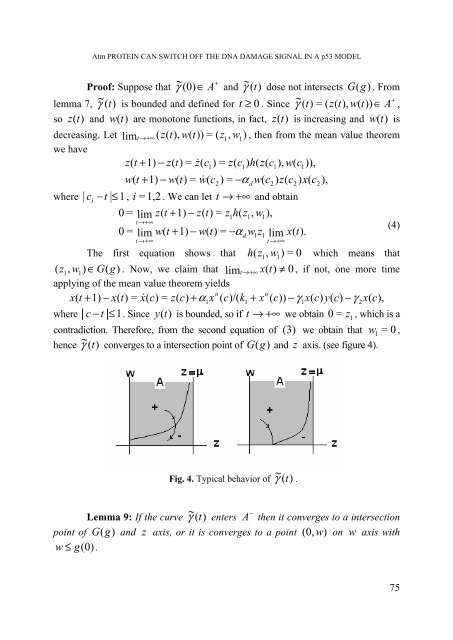biologia - Studia
biologia - Studia
biologia - Studia
You also want an ePaper? Increase the reach of your titles
YUMPU automatically turns print PDFs into web optimized ePapers that Google loves.
Atm PROTEIN CAN SWITCH OFF THE DNA DAMAGE SIGNAL IN A p53 MODEL<br />
+<br />
Proof: Suppose that ~γ (0)∈ A and<br />
~ γ ( t ) dose not intersects G (g)<br />
. From<br />
lemma 7,<br />
~ γ ( t ) is bounded and defined for t ≥ 0 . Since ~γ +<br />
( t ) = ( z(<br />
t),<br />
w(<br />
t))<br />
∈ A ,<br />
so z (t)<br />
and w (t)<br />
are monotone functions, in fact, z (t)<br />
is increasing and w (t)<br />
is<br />
decreasing. Let lim ( z ( t ), w ( t )) = ( z 1,<br />
w<br />
t → +∞<br />
1)<br />
, then from the mean value theorem<br />
we have<br />
z(<br />
t + 1) − z(<br />
t)<br />
= z&<br />
( c ) = z(<br />
c ) h(<br />
z(<br />
c ), w(<br />
c )),<br />
w(<br />
t + 1) − w(<br />
t)<br />
= w&<br />
( c2)<br />
= −α d<br />
w(<br />
c2)<br />
z(<br />
c2)<br />
x(<br />
c2),<br />
where | c i<br />
− t | ≤ 1 , i = 1,2 . We can let t → +∞ and obtain<br />
0 = lim z(<br />
t + 1) − z(<br />
t)<br />
= z h(<br />
z , w ),<br />
t→+∞<br />
0 = lim w(<br />
t + 1) − w(<br />
t)<br />
= −α<br />
w z<br />
t→+∞<br />
1<br />
1<br />
1<br />
d<br />
1<br />
1<br />
1<br />
1<br />
lim x(<br />
t).<br />
1 1<br />
t→+∞<br />
( z , w 1 1)<br />
The first equation shows that h = 0 which means that<br />
( z1,<br />
w1<br />
) ∈ G(<br />
g)<br />
. Now, we claim that limt<br />
→+∞<br />
x(<br />
t)<br />
≠ 0 , if not, one more time<br />
applying of the mean value theorem yields<br />
n<br />
n<br />
x( t + 1) − x(<br />
t)<br />
= x&<br />
( c)<br />
= z(<br />
c)<br />
+ α1x<br />
( c)/(<br />
k1<br />
+ x ( c))<br />
− γ<br />
1x(<br />
c)<br />
y(<br />
c)<br />
− γ<br />
2x(<br />
c),<br />
where | c − t |≤ 1. Since y (t)<br />
is bounded, so if t → +∞ we obtain 0 = z<br />
1<br />
, which is a<br />
contradiction. Therefore, from the second equation of (3) we obtain that w<br />
1<br />
= 0 ,<br />
hence<br />
~ γ ( t ) converges to a intersection point of G (g)<br />
and z axis. (see figure 4).<br />
(4)<br />
~ t<br />
Fig. 4. Typical behavior of γ ( ) .<br />
Lemma 9: If the curve<br />
~ γ ( t ) enters<br />
−<br />
A then it converges to a intersection<br />
point of G (g)<br />
and z axis, or it is converges to a point (0, w ) on w axis with<br />
w ≤ g(0) .<br />
75
















